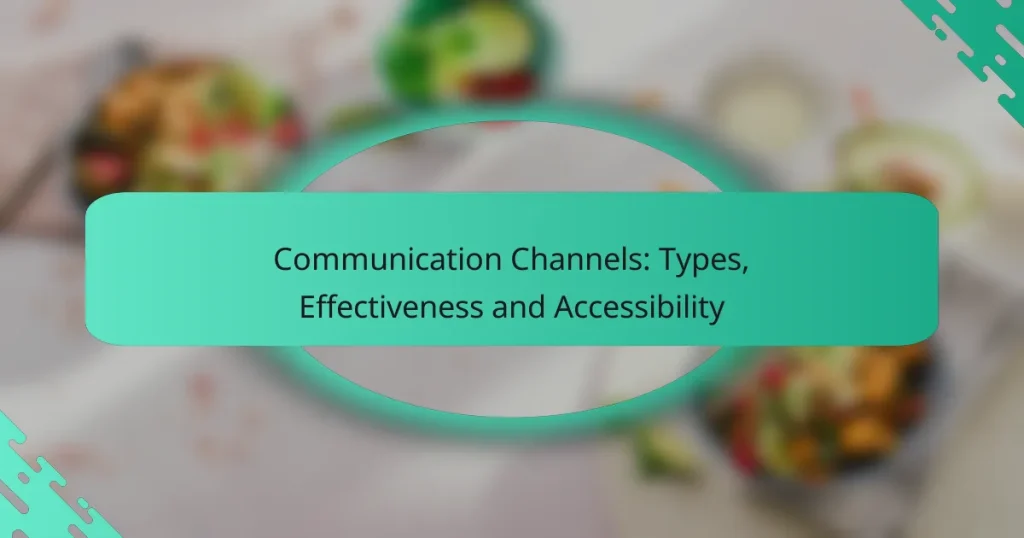Effective communication channels are essential for engaging local customers, with options such as social media, email, phone calls, text messaging, and in-person meetings each offering distinct advantages. The choice of channel not only impacts customer satisfaction and response times but also plays a crucial role in the overall quality of interactions. Additionally, ensuring accessibility in these channels allows users of varying abilities to engage meaningfully, enhancing their overall experience.
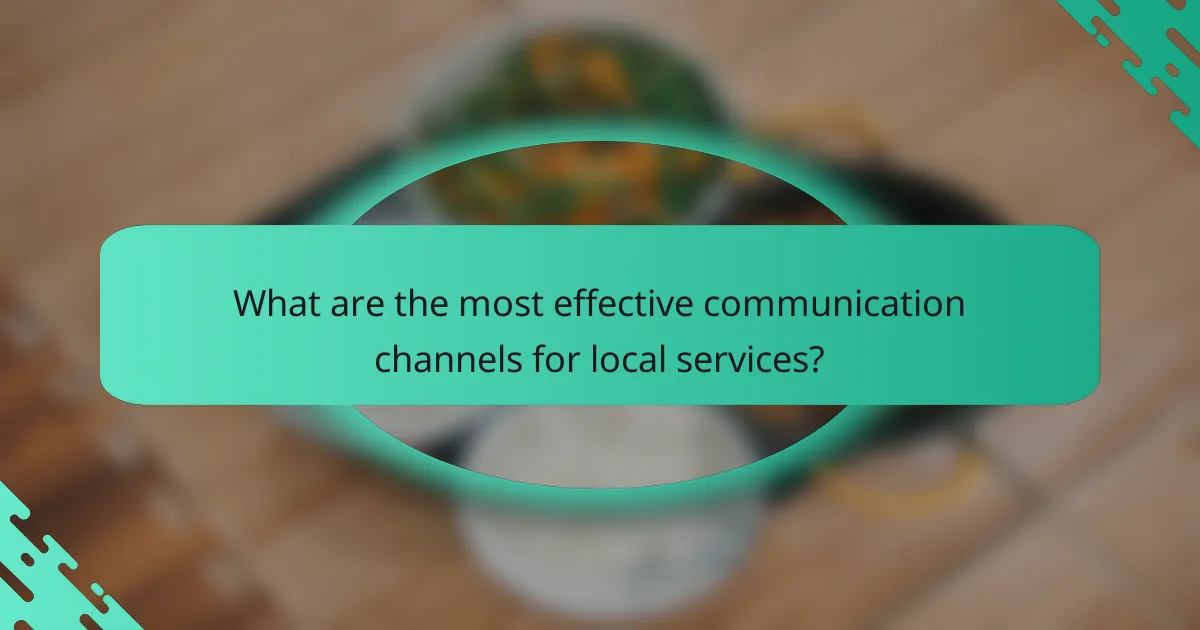
What are the most effective communication channels for local services?
The most effective communication channels for local services include social media platforms, email marketing, phone calls, text messaging, and in-person meetings. Each channel has unique strengths and considerations that can enhance engagement with local customers.
Social media platforms
Social media platforms like Facebook, Instagram, and Twitter are vital for local services to connect with their community. These channels allow for real-time interaction, sharing updates, and showcasing products or services visually.
Consider using targeted ads to reach specific demographics within your locality. Engaging content, such as local events or promotions, can significantly increase visibility and customer interaction.
Email marketing
Email marketing remains a powerful tool for local services, enabling direct communication with customers. Personalized emails can inform subscribers about promotions, events, or new offerings, fostering loyalty and repeat business.
To maximize effectiveness, segment your email list based on customer preferences and behaviors. Aim for a consistent schedule, such as monthly newsletters, to keep your audience engaged without overwhelming them.
Phone calls
Phone calls provide a personal touch that can enhance customer relationships for local services. They are particularly effective for addressing inquiries, resolving issues, or scheduling appointments.
Ensure your staff is trained to handle calls professionally and efficiently. Consider setting specific hours for customer service calls to manage expectations and improve response times.
Text messaging
Text messaging is an increasingly popular communication channel for local services, offering quick and direct contact with customers. It is ideal for sending reminders, confirmations, or urgent updates.
Utilize SMS marketing to share exclusive offers or promotions, but be mindful of frequency to avoid overwhelming customers. Always obtain consent before sending messages to comply with regulations.
In-person meetings
In-person meetings are essential for building trust and rapport in local services. They allow for detailed discussions and personalized service, which can significantly enhance customer satisfaction.
When scheduling meetings, consider the convenience of your clients. Offer flexible times and locations, and ensure that your team is prepared to address specific customer needs during these interactions.
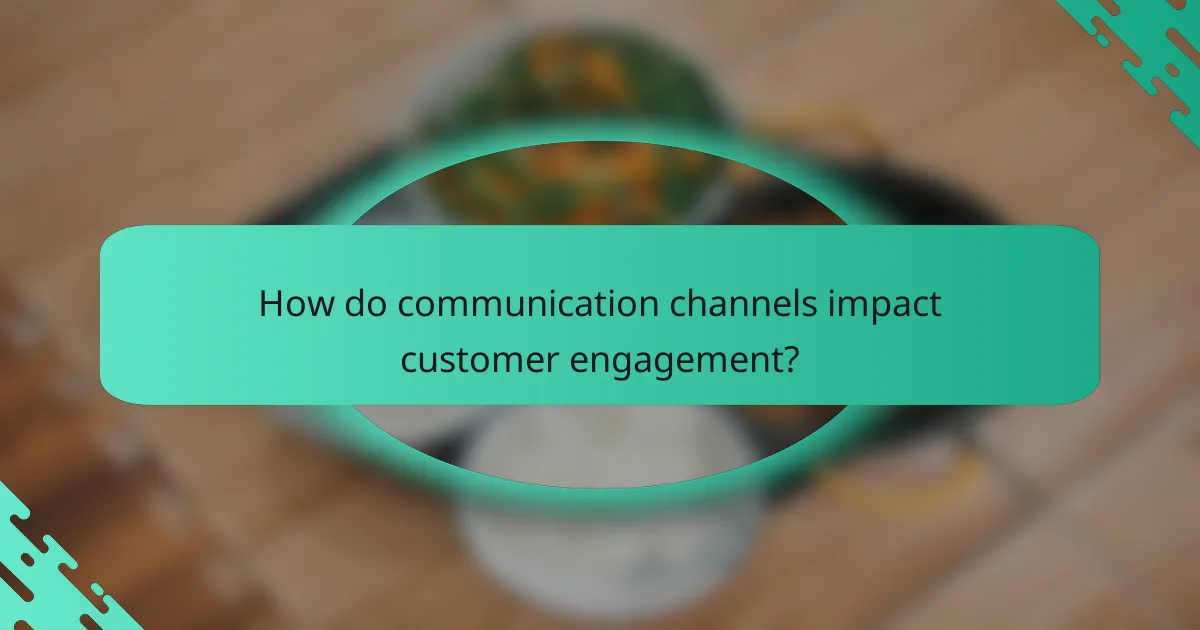
How do communication channels impact customer engagement?
Communication channels significantly influence customer engagement by determining how effectively businesses can connect with their audience. The choice of channel affects response times, customer satisfaction, and overall interaction quality.
Increased response rates
Utilizing the right communication channels can lead to higher response rates from customers. For instance, channels like live chat and social media often yield quicker replies compared to email, which may take hours or days. Businesses should analyze their audience’s preferences to select the most effective channels for prompt engagement.
To maximize response rates, consider offering multiple communication options. A combination of instant messaging, email, and phone support can cater to diverse customer needs, ensuring that they can reach out in their preferred way.
Enhanced customer satisfaction
Effective communication channels enhance customer satisfaction by providing timely and relevant information. When customers receive quick responses through their preferred channels, they feel valued and understood. This positive experience can lead to increased trust and loyalty.
To boost satisfaction, ensure that your communication channels are user-friendly and accessible. Regularly gather feedback to identify areas for improvement and adapt your strategies accordingly, such as optimizing response times or simplifying contact processes.
Improved brand loyalty
Consistent and effective communication fosters brand loyalty among customers. When businesses engage with their audience through preferred channels, they create a sense of community and connection. This ongoing interaction can lead to repeat business and positive word-of-mouth referrals.
To strengthen brand loyalty, maintain a consistent voice and message across all channels. Additionally, consider implementing loyalty programs or personalized communication strategies that reward customers for their engagement, further encouraging their commitment to your brand.
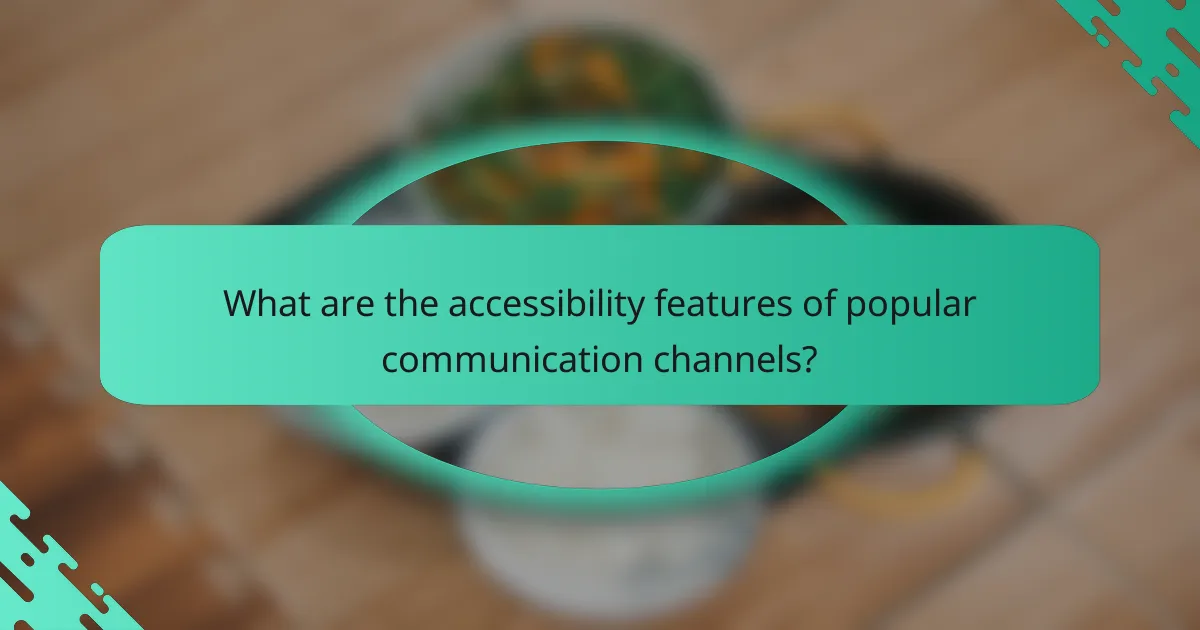
What are the accessibility features of popular communication channels?
Accessibility features in communication channels ensure that users with varying abilities can effectively engage with content. These features often include mobile accessibility, language support, and visual aids, which cater to diverse needs and enhance user experience.
Mobile accessibility
Mobile accessibility refers to how well communication channels function on mobile devices, which is crucial as many users rely on smartphones for connectivity. Features such as responsive design, voice commands, and screen readers help users with disabilities navigate applications and websites more easily.
When designing for mobile accessibility, consider using larger touch targets, ensuring text is readable without zooming, and providing alternative text for images. Testing with real users can uncover potential barriers and improve overall usability.
Language support
Language support in communication channels allows users to interact in their preferred language, which is essential for inclusivity. This can include multilingual interfaces, translation features, and localized content that resonate with specific cultural contexts.
To enhance language support, provide options for users to select their language easily and ensure that translations are accurate and contextually appropriate. Regularly updating language options based on user feedback can also improve engagement.
Visual aids
Visual aids enhance understanding and retention of information in communication channels. These can include images, infographics, videos, and charts that convey complex ideas in a more digestible format.
When incorporating visual aids, ensure they are accompanied by descriptive text or captions for users with visual impairments. Using high-contrast colors and clear fonts can also improve accessibility for users with low vision, making content more engaging and easier to comprehend.
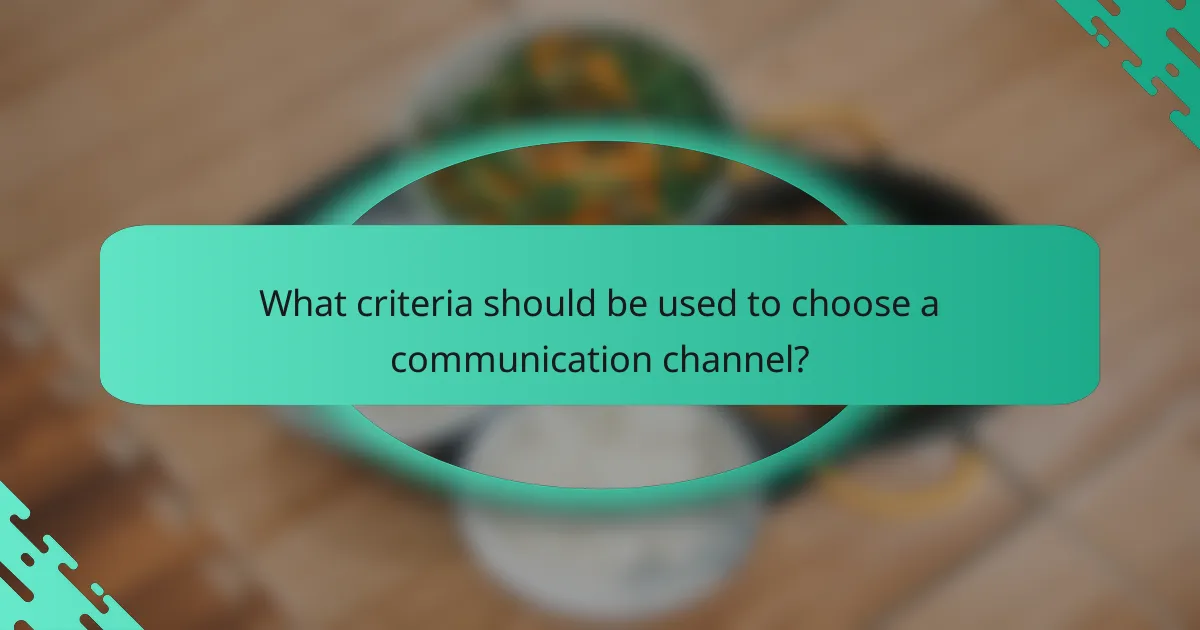
What criteria should be used to choose a communication channel?
Choosing a communication channel involves evaluating factors such as the target audience, the effectiveness of the channel, and associated costs. These criteria help ensure that the selected method aligns with the goals of the communication and reaches the intended recipients effectively.
Target audience preferences
Understanding the preferences of your target audience is crucial when selecting a communication channel. Different demographics may favor specific platforms; for instance, younger audiences often prefer social media, while older groups might lean towards email or phone calls.
Conducting surveys or analyzing existing data can provide insights into your audience’s preferred communication methods. Tailoring your approach based on these preferences increases engagement and ensures your message is received as intended.
Channel effectiveness
The effectiveness of a communication channel can vary significantly based on the message type and context. For example, visual content may perform better on platforms like Instagram, while detailed information is often better suited for email or reports.
Consider metrics such as response rates, engagement levels, and the speed of communication when evaluating effectiveness. Testing multiple channels can help identify which ones yield the best results for your specific needs.
Cost considerations
Cost is a vital factor when choosing a communication channel, as different methods come with varying expenses. For instance, email marketing can be relatively low-cost compared to traditional print advertising, which may require significant investment.
Assess both direct costs, such as subscription fees, and indirect costs, like time spent managing communications. Balancing cost with effectiveness ensures that you maximize your budget while achieving your communication goals.
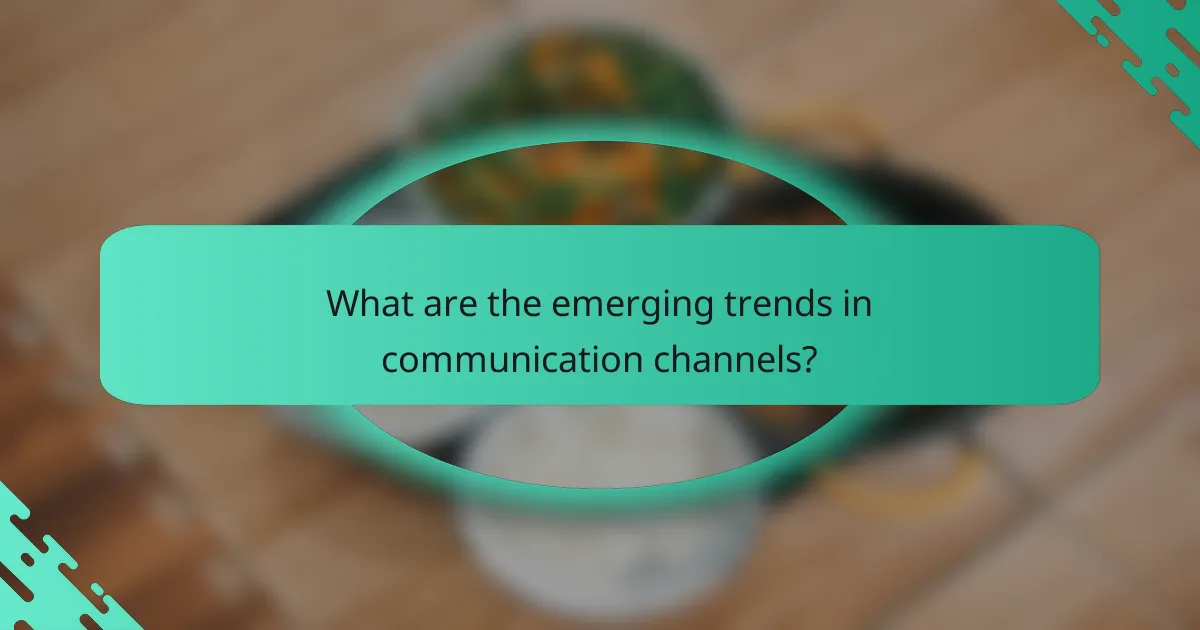
What are the emerging trends in communication channels?
Emerging trends in communication channels focus on the integration of technology, personalization, and real-time interaction. Channels like social media, instant messaging, and video conferencing are evolving to enhance user engagement and accessibility.
Increased use of AI in communication
Artificial intelligence (AI) is increasingly being integrated into communication channels to streamline interactions and improve user experience. Chatbots, for example, can provide instant responses to customer inquiries, reducing wait times and enhancing satisfaction.
Moreover, AI can analyze communication patterns to offer personalized content, making interactions more relevant. Businesses adopting AI-driven tools can expect to see improved efficiency and customer engagement.
Rise of video communication
Video communication has surged in popularity, particularly due to remote work trends. Platforms like Zoom and Microsoft Teams facilitate face-to-face interactions, which can enhance collaboration and build stronger relationships.
When using video channels, ensure a stable internet connection and appropriate lighting to maintain professionalism. Consider scheduling regular video check-ins to foster team cohesion and accountability.
Emphasis on mobile-first communication
With the majority of users accessing information via mobile devices, a mobile-first approach to communication is essential. This trend includes optimizing content for smaller screens and utilizing apps that enhance user interaction.
To effectively reach mobile users, prioritize concise messaging and quick-loading content. Implementing push notifications can also keep users engaged without overwhelming them.
Focus on data privacy and security
As communication channels evolve, so do concerns regarding data privacy and security. Regulations like GDPR in Europe emphasize the importance of protecting user information, making it crucial for businesses to adopt secure communication practices.
Implement end-to-end encryption for sensitive communications and regularly update privacy policies to reflect current regulations. Educating users about data security can also build trust and encourage open communication.
